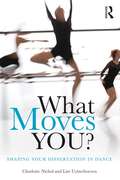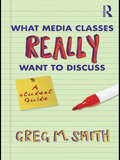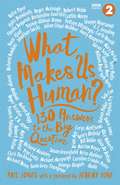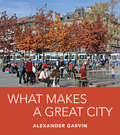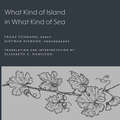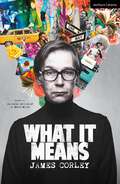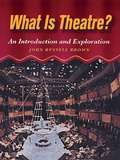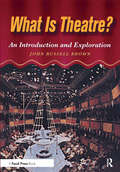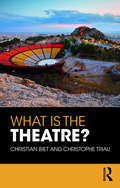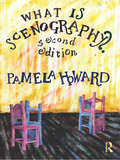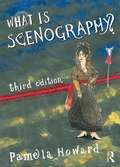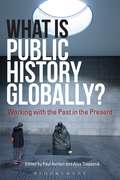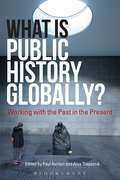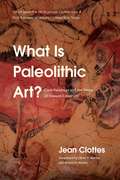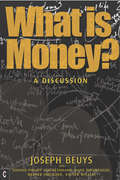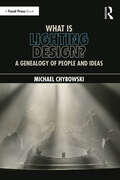- Table View
- List View
What Moves You?: Shaping your dissertation in dance
by Charlotte Nichol Lise UytterhoevenEvery dissertation is individual and unique - particularly for dance students, who must combine a wide range of approaches into a tailor-made research methodology. What Moves You? fosters a creative approach to dissertations and final projects. By guiding the development of a personal study program, this volume encourages dance students to take ownership of their artistic and academic work, a skill essential both to successful undergraduate study, and to making the first steps towards a career in dance. Rather than propose a prescriptive, step-by-step mantra, Charlotte Nichol and Lise Uytterhoeven draw upon contributions from students, teachers, examiners and practitioners to broaden the notion of ‘research’ and demystify the purpose of the dissertation.
What Moves You?: Shaping your dissertation in dance
by Charlotte Nichol Lise UytterhoevenEvery dissertation is individual and unique - particularly for dance students, who must combine a wide range of approaches into a tailor-made research methodology. What Moves You? fosters a creative approach to dissertations and final projects. By guiding the development of a personal study program, this volume encourages dance students to take ownership of their artistic and academic work, a skill essential both to successful undergraduate study, and to making the first steps towards a career in dance. Rather than propose a prescriptive, step-by-step mantra, Charlotte Nichol and Lise Uytterhoeven draw upon contributions from students, teachers, examiners and practitioners to broaden the notion of ‘research’ and demystify the purpose of the dissertation.
What Media Classes Really Want to Discuss: A Student Guide
by Greg SmithYou probably already have a clear idea of what a "discussion guide for students" is: a series of not-very-interesting questions at the end of a textbook chapter. Instead of triggering thought-provoking class discussion, all too often these guides are time-consuming and ineffective. This is not that kind of discussion guide. What Media Classes Really Want To Discuss focuses on topics that introductory textbooks generally ignore, although they are prominent in students’ minds. Using approachable prose, this book will give students a more precise critical language to discuss “common sense” phenomena about media. The book acknowledges that students begin introductory film and television courses thinking they already know a great deal about the subject. What Media Classes Really Want To Discuss provides students with a solid starting point for discussing their assumptions critically and encourages the reader to argue with the book, furthering the 'discussion' on media in everyday life and in the classroom.
What Media Classes Really Want to Discuss: A Student Guide
by Greg SmithYou probably already have a clear idea of what a "discussion guide for students" is: a series of not-very-interesting questions at the end of a textbook chapter. Instead of triggering thought-provoking class discussion, all too often these guides are time-consuming and ineffective. This is not that kind of discussion guide. What Media Classes Really Want To Discuss focuses on topics that introductory textbooks generally ignore, although they are prominent in students’ minds. Using approachable prose, this book will give students a more precise critical language to discuss “common sense” phenomena about media. The book acknowledges that students begin introductory film and television courses thinking they already know a great deal about the subject. What Media Classes Really Want To Discuss provides students with a solid starting point for discussing their assumptions critically and encourages the reader to argue with the book, furthering the 'discussion' on media in everyday life and in the classroom.
What Makes Us Human?: 130 answers to the big question
by Jeremy Vine Phil JonesA dazzling insight into what gives meaning to our life and to us as a species.What makes us human? From Carlo Rovelli on the particles of dust that make us, to Caitlin Moran on the joy of Friday nights, and A C Grayling on how we express ourselves through culture: this illuminating book shares 130 mind-expanding answers to that question.We all want to understand our place in the universe and find a sense of purpose in the life. This book will help the reader navigate that journey with the help of leading names from the worlds of literature, history, philosophy, politics, sport, comedy and popular culture. Originally broadcast as a popular feature on the Jeremy Vine Show, What Makes Us Human? includes short essays from: Andrew Marr, Carlo Rovelli, Marian Keyes, Alain de Botton, Robert Webb, Richard Dawkins, Stephen Fry, and many more.
What Makes a Great City
by Alexander GarvinThis volume will help readers understand that any city can be changed for the better and inspire entrepreneurs, public officials, and city residents to do it themselves.
What Kind of Island in What Kind of Sea?
by Franz FühmannThe dignity of cognitively disabled people and the ethics of representing their lives are at the heart of an extraordinary yet little-known book first published in the former German Democratic Republic. Was für eine Insel in was für einem Meer, or What Kind of Island in What Kind of Sea (Rostock, Hinstorff, 1986) depicts residents of a church-run institution for people with cognitive disabilities in astonishing black-and-white photographs by Dietmar Riemann and in a probing, poignant essay by esteemed German writer Franz Fühmann. This important text, which moved from a medical model to a historical and cultural view of disability as an aspect of human identity and experience, is translated into English for the first time by Elizabeth Hamilton and includes reflections on the book and its impact. As fuller, global histories of disability are now being written, What Kind of Island in What Kind of Sea opens an essential window onto a formerly shuttered world, demonstrating the power of the arts to hone our capacity to perceive and appreciate human difference.
What it Means: Based on On Being Different by Merle Miller (Modern Plays)
by James CorleyThey say they've broken into the offices of Harper's Magazine and are staging a sit-inSeptember 1970, Harper's Magazine publish the article Homo/Hetero: The Struggle for Sexual Identity in which Joseph Epstein states "If I had the power to do so, I would wish homosexuality off the face of the earth". The Gay Activists Alliance stage a sit-in at the Harper's office. But there are many ways to protest. In his Glass House, hidden in the woods outside Brewster New York, Merle Miller - acclaimed journalist and former editor of Harper's Magazine - sits at his desk and begins to write. An emotional one-person voyage through history - some personal, some not - What It Means speaks directly to audiences about the importance of standing up for what you believe in, accepting the validity of one's own voice and taking a courageous step onto the platform that is offered to you. This edition was published to coincide with the world premiere stage production at Wilton's Music Hall in October 2023, from The Lot Productions.
What it Means: Based on On Being Different by Merle Miller (Modern Plays)
by James CorleyThey say they've broken into the offices of Harper's Magazine and are staging a sit-inSeptember 1970, Harper's Magazine publish the article Homo/Hetero: The Struggle for Sexual Identity in which Joseph Epstein states "If I had the power to do so, I would wish homosexuality off the face of the earth". The Gay Activists Alliance stage a sit-in at the Harper's office. But there are many ways to protest. In his Glass House, hidden in the woods outside Brewster New York, Merle Miller - acclaimed journalist and former editor of Harper's Magazine - sits at his desk and begins to write. An emotional one-person voyage through history - some personal, some not - What It Means speaks directly to audiences about the importance of standing up for what you believe in, accepting the validity of one's own voice and taking a courageous step onto the platform that is offered to you. This edition was published to coincide with the world premiere stage production at Wilton's Music Hall in October 2023, from The Lot Productions.
What is Theatre?: An Introduction and Exploration
by John BrownThis major introductory textbook is from one of the leading educators working in theatre today. What Is Theatre? will make its reader a better playgoer, responding more fully to performance, with a keener appreciation of all the resources of theatre-acting, design, direction, organization, theatre buildings, and audiences. By focusing on the best professional practice and the most helpful learning processes, Dr. Brown shows how to read a play-text and to see and hear its potential for performance. Throughout this book, suggestions are given for student essays and class discussions, to help both instructor and reader to clarify their thoughts on all aspects of theatre-going. While the main focus is on present-day theatre in North America, history is used to illuminate current practice. Theatres in Europe and Asia also feature in the discussion. A view is given of all contributors to performance, with special emphasis placed on actors and the plays they perform. This textbook is not tied to a few specific play-texts, but designed to be effective regardless of which play a student sees or reads. In Part Two, leading practitioners of different generations and cultural backgrounds describe their own work, providing a variety of perspectives on the contemporary theatre. All this is supplemented by nearly 100 black and white and color illustrations from productions, working drawings, and plans. This new text engages its readers in the realities of the theatre; it is up-to-date, comprehensive, and packed with practical advice for understanding how theatre works and how plays come alive in performance. John Russell Brown is professor of Theatre at the University of Michigan, Ann Arbor, and has taught at a variety of colleges including New York and Stanford Universities. For 15 years he was an associate director of the National Theatre in London, and he has directed plays in many other theatres including Cincinnati Playhouse, the Empty Space in Seattle, and the Clurman Theatre in New York. Professor Brown has written extensively about theatre, especially about Shakespeare and contemporary theatre. He is editor of The Oxford Illustrated History of Theatre.
What is Theatre?: An Introduction and Exploration
by John BrownThis major introductory textbook is from one of the leading educators working in theatre today. What Is Theatre? will make its reader a better playgoer, responding more fully to performance, with a keener appreciation of all the resources of theatre-acting, design, direction, organization, theatre buildings, and audiences. By focusing on the best professional practice and the most helpful learning processes, Dr. Brown shows how to read a play-text and to see and hear its potential for performance. Throughout this book, suggestions are given for student essays and class discussions, to help both instructor and reader to clarify their thoughts on all aspects of theatre-going. While the main focus is on present-day theatre in North America, history is used to illuminate current practice. Theatres in Europe and Asia also feature in the discussion. A view is given of all contributors to performance, with special emphasis placed on actors and the plays they perform. This textbook is not tied to a few specific play-texts, but designed to be effective regardless of which play a student sees or reads. In Part Two, leading practitioners of different generations and cultural backgrounds describe their own work, providing a variety of perspectives on the contemporary theatre. All this is supplemented by nearly 100 black and white and color illustrations from productions, working drawings, and plans. This new text engages its readers in the realities of the theatre; it is up-to-date, comprehensive, and packed with practical advice for understanding how theatre works and how plays come alive in performance. John Russell Brown is professor of Theatre at the University of Michigan, Ann Arbor, and has taught at a variety of colleges including New York and Stanford Universities. For 15 years he was an associate director of the National Theatre in London, and he has directed plays in many other theatres including Cincinnati Playhouse, the Empty Space in Seattle, and the Clurman Theatre in New York. Professor Brown has written extensively about theatre, especially about Shakespeare and contemporary theatre. He is editor of The Oxford Illustrated History of Theatre.
What is the Theatre?
by Christian Biet Christophe TriauWhat is the Theatre? is one of the most coherent and systematic descriptions and analyses of the theatre yet compiled. Theatre is, above all, spectacle. It is a fleeting performance, delivered by actors and intended for spectators. It is a work of the body, an exercise of voice and gesture addressed to an audience, most often in a specific location and with a unique setting. This entertainment event rests on the delivery of a thing promised and expected – a particular and unique performance witnessed by spectators who have come to the site of the performance for this very reason. To witness theatre is to take into account the performance, but it is also to take into account the printed text as readable object and a written proposition. In this book, Christian Biet and Christophe Triau focus on the practical, theoretical and historical positions that the spectator and the reader have had in relation to the locations that they frequent and the texts that they handle. They adopt two approaches: analysing the spectacle in its theatrical and historical context in an attempt to seek out the principles and paradigms of approaching the theatre experience on one hand, and analysing the dramaturgy of a production in order to establish lines of interpretation and how to read, represent and stage a text, on the other. This approach allows us to better understand the ties that link those who participate in the theatre to the practitioners who create theatrical entertainment.
What is the Theatre?
by Christian Biet Christophe TriauWhat is the Theatre? is one of the most coherent and systematic descriptions and analyses of the theatre yet compiled. Theatre is, above all, spectacle. It is a fleeting performance, delivered by actors and intended for spectators. It is a work of the body, an exercise of voice and gesture addressed to an audience, most often in a specific location and with a unique setting. This entertainment event rests on the delivery of a thing promised and expected – a particular and unique performance witnessed by spectators who have come to the site of the performance for this very reason. To witness theatre is to take into account the performance, but it is also to take into account the printed text as readable object and a written proposition. In this book, Christian Biet and Christophe Triau focus on the practical, theoretical and historical positions that the spectator and the reader have had in relation to the locations that they frequent and the texts that they handle. They adopt two approaches: analysing the spectacle in its theatrical and historical context in an attempt to seek out the principles and paradigms of approaching the theatre experience on one hand, and analysing the dramaturgy of a production in order to establish lines of interpretation and how to read, represent and stage a text, on the other. This approach allows us to better understand the ties that link those who participate in the theatre to the practitioners who create theatrical entertainment.
What Is Scenography? (PDF)
by Pamela HowardPamela Howard's What is Scenography? has become a classic text in contemporary theatre design and performance practice. In this second edition, the author expands on her holistic analysis of scenography as comprising space, text, research, art, performers, directors and spectators, to examine the changing nature of scenography in the twenty-first century. The book includes: case studies and anecdotes from Howard's own celebrated career illustrations of her own recent work, in full colour throughout an updated 'world view' of scenography, with definitions from the world's most famous and influential scenographers A direct and personal response to the question of how to define scenography by one of the world's leading practitioners, What is Scenography? continues to shape the work of visual theatremakers throughout the world.
What is Scenography?
by Pamela HowardThe third edition of Pamela Howard’s What is Scenography? expands on the author’s holistic analysis of scenography as comprising space, text, research, art, performers, directors and spectators, to examine the changing nature of scenography in the twenty-first century. The book includes new investigations of recent production projects from Howard’s celebrated career, including Carmen and Charlotte: A Tri-Coloured Play with Music, full-colour illustrations of her recent work and updated commentary from a wide spectrum of contemporary theatre makers. This book is suitable for students in Scenography and Theatre Design courses, along with professional theatrical designers.
What is Scenography? (Theatre Concepts Ser.)
by Pamela HowardThe third edition of Pamela Howard’s What is Scenography? expands on the author’s holistic analysis of scenography as comprising space, text, research, art, performers, directors and spectators, to examine the changing nature of scenography in the twenty-first century. The book includes new investigations of recent production projects from Howard’s celebrated career, including Carmen and Charlotte: A Tri-Coloured Play with Music, full-colour illustrations of her recent work and updated commentary from a wide spectrum of contemporary theatre makers. This book is suitable for students in Scenography and Theatre Design courses, along with theatre professionals.
What Is Public History Globally?: Working with the Past in the Present
by Paul Ashton Alex TrapeznikAcross the globe, history has gone public. With the rise of the internet, family historians are now delving into archives continents apart. Activists look into and recreate the past to promote social justice or environmental causes. Dark and difficult pasts are confronted at sites of commemoration. Artists draw on memory and the past to study the human condition and make meaning in the present. As a result of this democratisation of history, public history movements have now risen to prominence.This groundbreaking edited collection takes a comprehensive look at public history throughout the world. Divided into three sections - Background, Definitions and Issues; Approaches and Methods; and Sites of Public History - it contextualises public history in eleven different countries, explores the main research skills and methods of the discipline and illustrates public history research with a variety of global case studies. What is Public History Globally? provides an in-depth examination of the ways in which ordinary people become active participants in historical processes and it will be an invaluable resource for advance undergraduates and postgraduates studying public history, museology and heritage studies.
What Is Public History Globally?: Working with the Past in the Present
by Paul Ashton Alex TrapeznikAcross the globe, history has gone public. With the rise of the internet, family historians are now delving into archives continents apart. Activists look into and recreate the past to promote social justice or environmental causes. Dark and difficult pasts are confronted at sites of commemoration. Artists draw on memory and the past to study the human condition and make meaning in the present. As a result of this democratisation of history, public history movements have now risen to prominence.This groundbreaking edited collection takes a comprehensive look at public history throughout the world. Divided into three sections - Background, Definitions and Issues; Approaches and Methods; and Sites of Public History - it contextualises public history in eleven different countries, explores the main research skills and methods of the discipline and illustrates public history research with a variety of global case studies. What is Public History Globally? provides an in-depth examination of the ways in which ordinary people become active participants in historical processes and it will be an invaluable resource for advance undergraduates and postgraduates studying public history, museology and heritage studies.
What Is Paleolithic Art?: Cave Paintings and the Dawn of Human Creativity
by Jean ClottesWas it a trick of the light that drew our Stone Age ancestors into caves to paint in charcoal and red hematite, to watch the heads of lions, likenesses of bison, horses, and aurochs in the reliefs of the walls, as they flickered by firelight? Or was it something deeper—a creative impulse, a spiritual dawn, a shamanistic conception of the world efflorescing in the dark, dank spaces beneath the surface of the earth where the spirits were literally at hand? In this book, Jean Clottes, one of the most renowned figures in the study of cave paintings, pursues an answer to this “why” of Paleolithic art. While other books focus on particular sites and surveys, Clottes’s work is a contemplative journey across the world, a personal reflection on how we have viewed these paintings in the past, what we learn from looking at them across geographies, and what these paintings may have meant—what function they may have served—for their artists. Steeped in Clottes’s shamanistic theories of cave painting, What Is Paleolithic Art? travels from well-known Ice Age sites like Chauvet, Altamira, and Lascaux to visits with contemporary aboriginal artists, evoking a continuum between the cave paintings of our prehistoric past and the living rock art of today. Clottes’s work lifts us from the darkness of our Paleolithic origins to reveal, by firelight, how we think, why we create, why we believe, and who we are.
What Is Paleolithic Art?: Cave Paintings and the Dawn of Human Creativity
by Jean ClottesWas it a trick of the light that drew our Stone Age ancestors into caves to paint in charcoal and red hematite, to watch the heads of lions, likenesses of bison, horses, and aurochs in the reliefs of the walls, as they flickered by firelight? Or was it something deeper—a creative impulse, a spiritual dawn, a shamanistic conception of the world efflorescing in the dark, dank spaces beneath the surface of the earth where the spirits were literally at hand? In this book, Jean Clottes, one of the most renowned figures in the study of cave paintings, pursues an answer to this “why” of Paleolithic art. While other books focus on particular sites and surveys, Clottes’s work is a contemplative journey across the world, a personal reflection on how we have viewed these paintings in the past, what we learn from looking at them across geographies, and what these paintings may have meant—what function they may have served—for their artists. Steeped in Clottes’s shamanistic theories of cave painting, What Is Paleolithic Art? travels from well-known Ice Age sites like Chauvet, Altamira, and Lascaux to visits with contemporary aboriginal artists, evoking a continuum between the cave paintings of our prehistoric past and the living rock art of today. Clottes’s work lifts us from the darkness of our Paleolithic origins to reveal, by firelight, how we think, why we create, why we believe, and who we are.
What Is Paleolithic Art?: Cave Paintings and the Dawn of Human Creativity
by Jean ClottesWas it a trick of the light that drew our Stone Age ancestors into caves to paint in charcoal and red hematite, to watch the heads of lions, likenesses of bison, horses, and aurochs in the reliefs of the walls, as they flickered by firelight? Or was it something deeper—a creative impulse, a spiritual dawn, a shamanistic conception of the world efflorescing in the dark, dank spaces beneath the surface of the earth where the spirits were literally at hand? In this book, Jean Clottes, one of the most renowned figures in the study of cave paintings, pursues an answer to this “why” of Paleolithic art. While other books focus on particular sites and surveys, Clottes’s work is a contemplative journey across the world, a personal reflection on how we have viewed these paintings in the past, what we learn from looking at them across geographies, and what these paintings may have meant—what function they may have served—for their artists. Steeped in Clottes’s shamanistic theories of cave painting, What Is Paleolithic Art? travels from well-known Ice Age sites like Chauvet, Altamira, and Lascaux to visits with contemporary aboriginal artists, evoking a continuum between the cave paintings of our prehistoric past and the living rock art of today. Clottes’s work lifts us from the darkness of our Paleolithic origins to reveal, by firelight, how we think, why we create, why we believe, and who we are.
What Is Paleolithic Art?: Cave Paintings and the Dawn of Human Creativity
by Jean ClottesWas it a trick of the light that drew our Stone Age ancestors into caves to paint in charcoal and red hematite, to watch the heads of lions, likenesses of bison, horses, and aurochs in the reliefs of the walls, as they flickered by firelight? Or was it something deeper—a creative impulse, a spiritual dawn, a shamanistic conception of the world efflorescing in the dark, dank spaces beneath the surface of the earth where the spirits were literally at hand? In this book, Jean Clottes, one of the most renowned figures in the study of cave paintings, pursues an answer to this “why” of Paleolithic art. While other books focus on particular sites and surveys, Clottes’s work is a contemplative journey across the world, a personal reflection on how we have viewed these paintings in the past, what we learn from looking at them across geographies, and what these paintings may have meant—what function they may have served—for their artists. Steeped in Clottes’s shamanistic theories of cave painting, What Is Paleolithic Art? travels from well-known Ice Age sites like Chauvet, Altamira, and Lascaux to visits with contemporary aboriginal artists, evoking a continuum between the cave paintings of our prehistoric past and the living rock art of today. Clottes’s work lifts us from the darkness of our Paleolithic origins to reveal, by firelight, how we think, why we create, why we believe, and who we are.
What is Money?: A Discussion Featuring Joseph Beuys
by Joseph Beuys Ulrich RoschThe world of finance exerts a huge influence over our lives, being responsible for economic turmoil and seemingly interminable peaks and crashes. Whereas money was once a simple means of exchange, today it is a commodity in itself and as ‘capital’ exerts power over individuals, degrading work to tradable labour. Can we find a new way of understanding money today, so that we can begin to overcome its destructive aspects?In November 1984 a remarkable discussion took place at the Meeting House in Ulm, Germany. It featured the radical artist Joseph Beuys, two professors (of Financial Sciences and Political Economics) and a banker. Beuys would appear to be out of place among these heavyweight academics, professionals and authors. But rather than being intimidated by his fellow panellists, Beuys - also a social and political activist - demonstrates his groundbreaking thinking on the subject, and his ability to bring fresh perspectives. Here for the first time is a transcript of this debate, together with analysis by Ulrich Rösch, which will be of equal interest to artists, economists and spiritual seekers.
What Is Lighting Design?: A Genealogy of People and Ideas
by Michael ChybowskiWhat Is Lighting Design?: A Genealogy of People and Ideas explains what lighting design is by looking at the history of ideas that are a part of this craft and how those ideas developed. Lighting design began in the West with the Renaissance, and each historical period since then has modified how and why light is used in performance, the methods for producing light, and the consensus around what its purpose is. Exploring each lighting design era and the basic components of lighting design, the book discusses how the central ideas of this craft developed over the past 500 years, what today’s lighting designers are concerned with, and how lighting design contributes to performances. This book is designed as a main course text for History of Lighting Design university courses and a supplementary text for and Introduction to Lighting Design, Stagecraft, and Scenography courses. It will also be of interest to directors, choreographers, and working lighting designers who wish to explore the history and meaning of their craft.
What Is Lighting Design?: A Genealogy of People and Ideas
by Michael ChybowskiWhat Is Lighting Design?: A Genealogy of People and Ideas explains what lighting design is by looking at the history of ideas that are a part of this craft and how those ideas developed. Lighting design began in the West with the Renaissance, and each historical period since then has modified how and why light is used in performance, the methods for producing light, and the consensus around what its purpose is. Exploring each lighting design era and the basic components of lighting design, the book discusses how the central ideas of this craft developed over the past 500 years, what today’s lighting designers are concerned with, and how lighting design contributes to performances. This book is designed as a main course text for History of Lighting Design university courses and a supplementary text for and Introduction to Lighting Design, Stagecraft, and Scenography courses. It will also be of interest to directors, choreographers, and working lighting designers who wish to explore the history and meaning of their craft.
